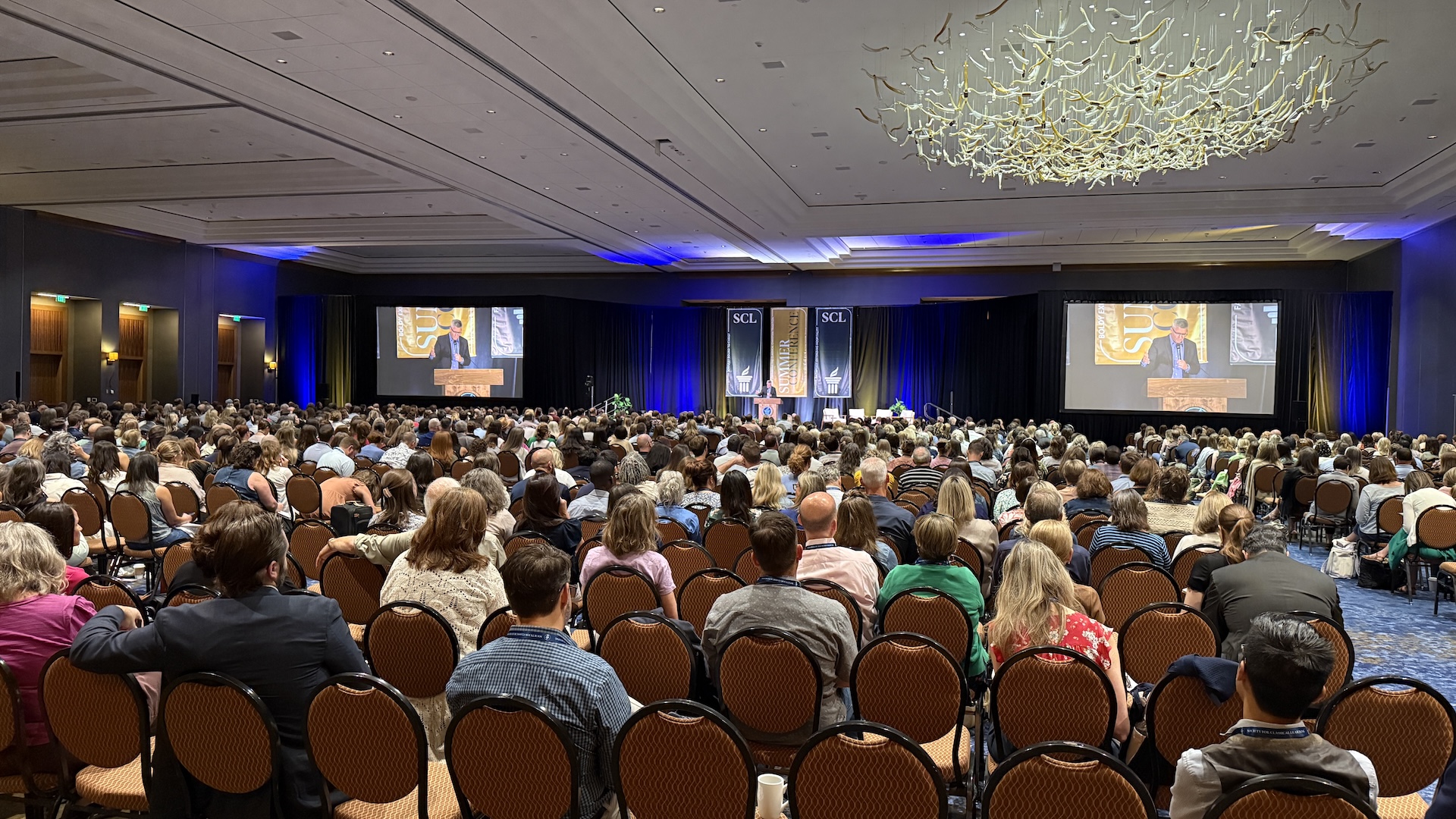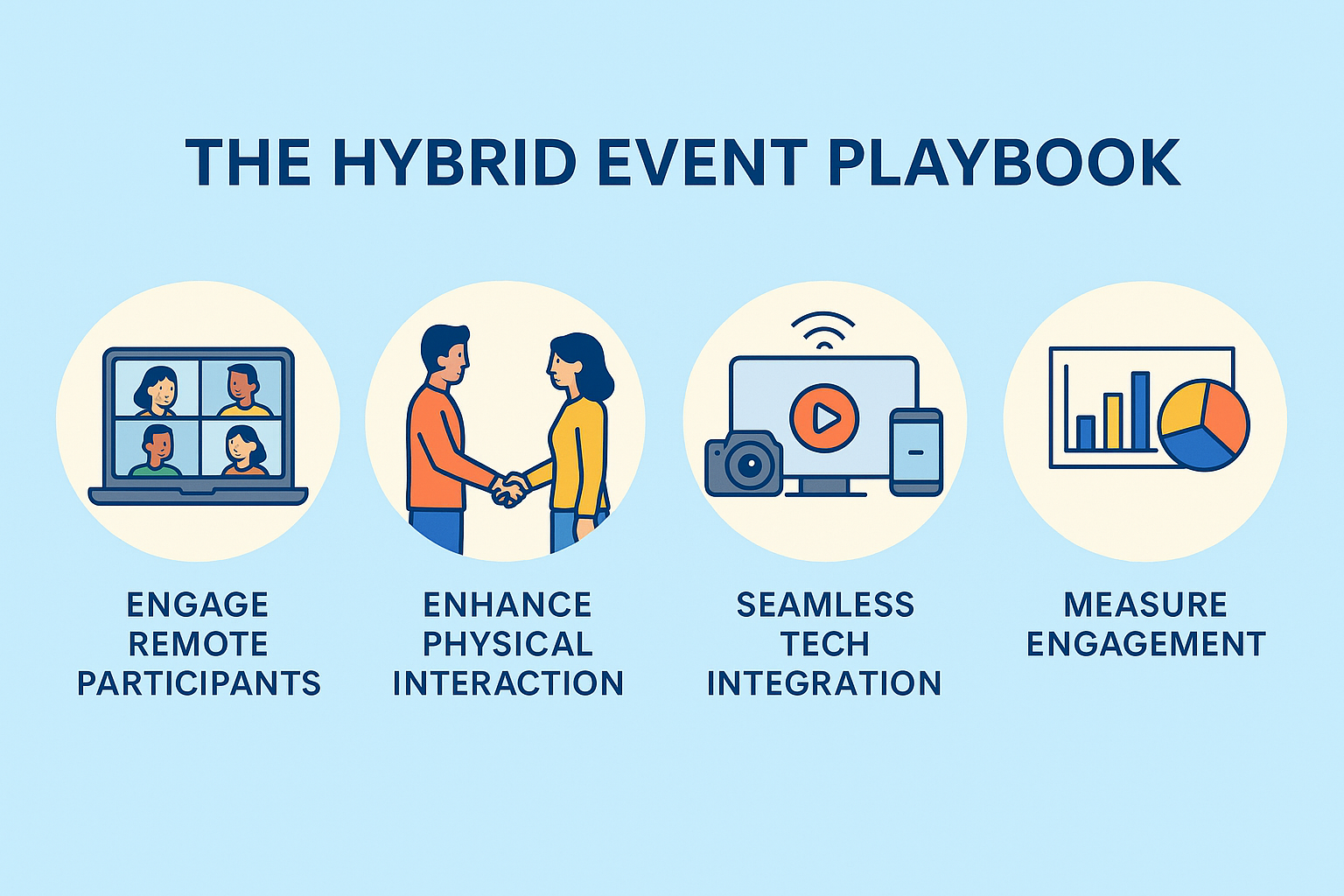
In today’s fast-paced business world, hybrid events have become the new standard for corporate communication. The event planning industry has rapidly evolved to embrace hybrid formats, adapting to new technologies and shifting attendee expectations. Whether it’s a quarterly town hall, an industry conference, or a product launch, more organizations are combining in-person and remote experiences to reach wider audiences while keeping engagement high.
A prime example of innovative hybrid and virtual event presentations is apple's special events, which showcase new product launches and technology updates to massive global audiences. These high-profile events demonstrate how multi-channel formats can maximize reach and set new standards for audience engagement.
But let’s be honest — hybrid events aren’t easy. You’re not just managing a room full of attendees; you’re also managing an online audience that’s tuning in from around the world. Balancing both can feel like juggling two entirely different shows at once.
That’s where having a plan — a Hybrid Event Playbook — makes all the difference. A well-designed event strategy is essential for aligning both in-person and remote components, ensuring a seamless and engaging experience for all attendees.
A hybrid event isn’t just a live stream of an in-person experience. It’s a dual production.
A hybrid event includes both in-person and online components, allowing you to maximize impact and flexibility by reaching audiences wherever they are.
You’re creating two simultaneous experiences that need to feel equally engaging, even though they’re happening in different spaces. A buddy system can pair remote attendees with in-person participants, ensuring inclusivity and real-time updates during events.
When done right, hybrid events help companies:
The key? Developing a hybrid event strategy and designing your event for both audiences from the start — not treating virtual attendees as an afterthought. This approach optimizes engagement and ensures a seamless experience for everyone involved.

The secret to a successful hybrid event starts with how it’s produced.
At DFW Live Stream, we’ve learned that great hybrid production comes down to three pillars:
Think of hybrid production like a TV broadcast — it’s not just “capturing” an event; it’s creating an experience that feels intentional from every perspective. Seamless integration between live and virtual components is essential to deliver a unified event experience for all attendees. Hybrid events blend physical events with virtual experiences, creating a comprehensive environment that maximizes engagement and accessibility.
Hybrid events offer a world of possibilities for connecting with your audience—no matter where they are. By blending the best of in-person and virtual events, you can create experiences that are both dynamic and inclusive. Here are some hybrid event ideas to inspire your next event strategy:
By incorporating these hybrid event ideas, you can ensure your events are engaging, accessible, and memorable for both in-person and virtual audiences. Hybrid events offer the flexibility to tailor experiences to different preferences, maximizing reach and impact with just a few clicks.
In-person energy is easy — applause, laughter, Q&A sessions. Virtual engagement requires more intention. Engagement tools such as Q&As, polls, and emoji reactions are essential to keep both in-person and virtual participants involved and actively engaged. Audience engagement features like live chat, polling, and quizzes are crucial for maintaining participation and attention from all attendees. Scheduling breaks during sessions can combat screen-time fatigue for virtual attendees.
Here are five ways to connect both audiences and keep them involved throughout your event:
Hybrid engagement is about equity. Your in-person crowd sees the stage; your online audience should see themselves reflected in the program. Breakout rooms and group chats can help create a more interactive and engaging event experience for all audience members, both in-person and virtual, by using tailored strategies to connect and engage everyone.
A successful hybrid event is only as strong as the platform that connects your in-person and virtual audiences. The event platform acts as the central hub, ensuring that every attendee—whether sitting in the front row or joining from across the globe—has a seamless, interactive experience.
Choosing the right hybrid event platform is a strategic decision for event planners. Selecting the best hybrid event platform is crucial for ensuring event success and meeting your engagement goals. It’s not just about live streaming your content; it’s about creating a unified space where both in-person and virtual attendees can participate fully. The best hybrid event platforms offer intuitive navigation, robust security, and flexible customization, allowing you to tailor the event to your brand and audience needs.
Look for platforms that support live streaming with minimal lag, offer interactive tools like polls and Q&A, and enable breakout sessions for smaller group discussions. Integration with registration systems, CRMs, and analytics tools can also streamline your event planning process and provide valuable insights post-event. It is important for hybrid event platforms to be user-friendly to accommodate all users regardless of tech skills.
Ultimately, the right hybrid event platform bridges the gap between physical and virtual, making it possible to deliver a successful hybrid event that feels cohesive and engaging for everyone involved. By prioritizing features that foster connection and participation, you set the stage for memorable experiences—no matter where your audience is joining from.
One major benefit of hybrid events is the data you collect. Hybrid events combine the best of traditional in person events and online participation, and can also include on-demand content to allow audiences to view missed sessions later. Repurposing recorded sessions as on-demand content is also a powerful strategy for lead generation after the event.
You can now measure things you could never track at a traditional in person event:
These insights, including data driven insights and instant feedback from polls and chat activity, help you refine future events and understand what truly resonates with your audience.
At DFW Live Stream, we often deliver post-event engagement reports that reveal not just who attended — but how they interacted. This turns your hybrid event into an ongoing feedback loop, helping you grow engagement every time you go live.
Hosting a successful hybrid event means navigating a unique set of challenges—but with the right approach, you can turn potential obstacles into opportunities for engagement. Here’s how to address some of the most common issues:
By anticipating these challenges and leveraging the right event platform and engagement tools, event planners can deliver a successful hybrid event that keeps both in-person and virtual attendees engaged from start to finish.
A comprehensive event plan is essential for the success of any hybrid event, ensuring all aspects are covered from audience engagement to technical execution. Hosting hybrid events that are well-organized and interactive is key to delivering a memorable experience for both in-person and virtual participants.
Before you hit “go live”, use this short checklist to ensure both audiences are covered:
✅ Conduct a site visit to test lighting, audio, and connectivity.
✅ Decide how virtual attendees will see in-person visuals (slides, presenters, camera angles).
✅ Assign clear roles — producer, camera ops, stream tech, virtual moderator.
✅ Define your target audience before planning content and engagement strategies.
✅ Plan for hybrid meetings by considering the necessary equipment, environmental benefits, and logistics to support both live and remote participants.
✅ Event organizers should prepare for potential technical issues and have troubleshooting protocols in place.
✅ Rehearse transitions between in-person and remote speakers to ensure a smooth hybrid meeting experience.
✅ Always have a backup internet source and local recordings.
A little pre-planning creates a seamless, confident experience for everyone watching — whether they’re in the front row or halfway across the world. Hybrid meetings offer flexibility and require careful planning to ensure a seamless experience for all participants.
A well-planned budget is the backbone of any successful hybrid event. To ensure a seamless experience for both in-person and virtual audiences, consider these essential budget categories:
By carefully planning and allocating your budget, event planners can create a successful hybrid event that delivers value to every attendee—whether they’re in the room or joining remotely.
Security is a top priority for hybrid events, ensuring that both in-person and virtual attendees can participate with confidence. Here’s how to keep your event safe and secure:
By prioritizing security at every stage, event planners can create a safe and welcoming environment for both in-person and virtual attendees, ensuring a successful hybrid event for all.
Hybrid isn’t a passing trend — it’s the future of communication. Hybrid events are shaping the future of the event industry, with virtual and hybrid events becoming essential for organizations looking to maximize reach and engagement. In particular, the hybrid conference will play a central role in the evolving event landscape by seamlessly integrating in-person and virtual components for all participants.
As companies continue to embrace flexible work and global teams, hybrid events will remain the go-to format for connection. Using a reliable virtual event platform is crucial to support attendee engagement, manage registration, and seamlessly integrate virtual and in-person components. Delivering a high-quality virtual experience for online attendees is just as important as engaging the in person audience and live audience, ensuring a balanced and interactive event for everyone involved.
And with the right planning, technology, and creative approach, you can make every attendee feel like they’re in the same room — no matter where they are. Creating an engaging virtual space that mirrors the energy of the physical event is key to connecting both audiences. While hybrid events blend the best of both worlds, virtual only events offer unique advantages when in-person gatherings aren’t possible, providing flexibility and safety. Partnering with experienced production teams helps create memorable experiences for both in-person and remote audiences, ensuring your event stands out.
If you’re ready to explore how hybrid production can elevate your next event, DFW Live Stream can help. From multi-camera setups to custom viewing pages, we make sure your message is seen, heard, and remembered.
The end of your hybrid event is just the beginning of ongoing engagement. Effective follow-up helps you turn event moments into lasting momentum:
By following up thoughtfully, event planners and organizers can nurture relationships, build community, and ensure that the energy of your hybrid event carries forward into future opportunities.